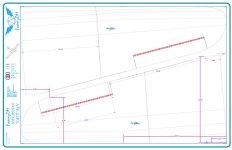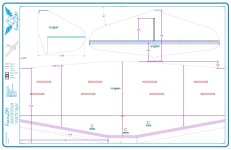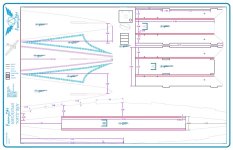
A friend of mine recently reached out with a design challenge/idea. He wanted my design expertise for a project he was finishing up. He needed a target. The Design criteria were as follows:
- Big enough to target at ~100'-150' away - 50-60" WS
- Slow Flyer, he wanted enough time to target and fire a few shots in a pass
- Simple/Easy and quick to build. He wanted to be able to build a number of them quickly.
- He suggested the B5N Kate Torpedo Bomber
History:
The Nakajima B5N (Japanese: 中島 B5N, Allied reporting name "Kate") was the standard carrier-based torpedo bomber of the Imperial Japanese Navy (IJN) for much of World War II. It also served as a high level bomber.
Although the B5N was substantially faster and more capable than its Allied counterparts, the American Douglas TBD Devastator monoplane (the U.S. Navy's first all-metal, carrier-borne monoplane of any type with retracting gear), and the British Fairey Swordfish and Fairey Albacore torpedo biplanes, it was nearing obsolescence by 1941. Nevertheless, the B5N operated throughout the whole war, due to the delayed development of its successor, the B6N.
In the early part of the Pacific War, when flown by well-trained IJN aircrews and as part of well-coordinated attacks, the B5N achieved particular successes at the battles of Pearl Harbor, Coral Sea, Midway, and Santa Cruz Islands.[2][3]
Operations:
The B5N was primarily employed as a carrier-based aircraft and occasionally as a land-based bomber. It carried a crew of three: pilot, navigator/bombardier/observer, and radio-operator/gunner.[10] Like with other IJN multi-seat aircraft, an individual bomber was commanded by the senior ranking crew member aboard, which could be the observer rather than the pilot.[11]
The initial model B5N1 first saw action in the Second Sino-Japanese War in 1938. The updated B5N2 played a major role in the Attack on Pearl Harbor. One of the B5N2s carried Mitsuo Fuchida, the commander of the attack, with one high-level bomber from the carrier Hiryū credited with sinking the American battleship Arizona. The B5N2 torpedo bombers also sunk the battleships West Virginia, California, Oklahoma and Utah. Five torpedo bombers were shot down in the first wave. Apart from this raid, the greatest successes of the B5N2 were the key roles it played in sinking the United States Navy aircraft carrier Lexington at the Battle of the Coral Sea and the aircraft carrier Hornet at the Battle of the Santa Cruz Islands, and the disabling of the aircraft carrier Yorktown at the Battle of Midway, later sunk by the Japanese submarine I-168.[2][3]
B5N2 torpedo bombers normally performed a coordinated attack on enemy carriers with Aichi D3A dive bombers. Ideally, dive bombers would help to suppress the ship's anti-aircraft fire, which improved the chances of success for the slow-flying torpedo bombers.[11] During the Battle of the Eastern Solomons, the IJN tried to minimize losses to torpedo bombers and initially sent only the dive bombers to attack and cripple US carriers for the subsequent torpedo strike, this proved unsuccessful, as the torpedo bombers did not launch until the battle was over.[12]
The B5N served as the basis for a follow-on design, the B6N, which eventually replaced it in front-line service. The B5N continued to fly in secondary roles, such as training, target towing, and anti-submarine warfare. Some of the aircraft used for this latter purpose were equipped with early radars and magnetic anomaly detectors. B5Ns were also used as bombers during the unsuccessful defense of the Philippines in October 1944, suffering severe losses. Later in the war, they were used for kamikaze attacks.
Production survivors:
None of the 1,150 production B5Ns survived World War II intact. Only two partially-recovered B5Ns are known to exist, neither of them airworthy.

(from the Pearl Harbor Museum website)
General characteristics
- Crew: 3
- Length: 10.3 m (33 ft 10 in)
- Wingspan: 15.518 m (50 ft 11 in)
- Height: 3.7 m (12 ft 2 in)
- Wing area: 37.7 m2 (406 sq ft)
- Airfoil: root: NN-5 mod (16%); tip: NN-5 mod (8%)[16]
- Empty weight: 2,279 kg (5,024 lb)
- Gross weight: 3,800 kg (8,378 lb)
- Max takeoff weight: 4,100 kg (9,039 lb)
- Powerplant: 1 × Nakajima Sakae 11 14-cylinder air-cooled radial piston engine, 750 kW (1,000 hp) for take-off
- Propellers: 3-bladed constant-speed metal propeller
- Maximum speed: 378 km/h (235 mph, 204 kn) at 3,600 m (11,811 ft)
- Cruise speed: 259 km/h (161 mph, 140 kn) at 3,000 m (9,843 ft)
- Range: 978 km (608 mi, 528 nmi)
- Ferry range: 1,991 km (1,237 mi, 1,075 nmi)
- Service ceiling: 8,260 m (27,100 ft)
- Rate of climb: 6.5 m/s (1,280 ft/min)
- Time to altitude: 3,000 m (9,843 ft) in 7 minutes 40 seconds
- Wing loading: 100.8 kg/m2 (20.6 lb/sq ft)
- Power/mass: 0.196 kW/kg (0.119 hp/lb)
- Guns: 1 × 7.7 mm Type 92 machine gun 'Ru' (Lewis) in rear dorsal position, fed by hand loaded drum magazines of 97 rounds. A number of B5N1s were equipped with 2 × 7.7 Type 97 machine guns in the wings.
- Bombs: 1 × 800 kg (1,760 lb) Type 91 torpedo or 1 × 800 kg (1,760 lb) bomb or 2 × 250 kg (550 lb) bombs or 6 × 60 kg (132 lb) bombs[17]
https://www.militaryfactory.com/aircraft/detail.php?aircraft_id=374
https://www.pearlharboraviationmuseum.org/aircraft/nakajima-b5n/
https://en.wikipedia.org/wiki/Nakajima_B5N#
RC Manuf. - https://aerofred.com/details.php?image_id=94544
Cad Model: https://www.themodellingnews.com/2022/07/preview-border-models-new-nakajima-b5n2.html
The Build:
I dimensioned my plan set so that every who finds this easier, can just lay it out on the foam board. (for me this is new). I put straight lines for most of the cuts on this plane, short of the surface tips. I was able to draw out this plane on the foam board in about half the time it took me to tape all the A4/Letter size sheets together and glue down.

In this plane I installed the SunnySky 2218 1150kv motor swinging a 10" Slow fly prop. this setup is paired with a 40A ESC power with a 2200mah 3S Batter. *A Special Note is that this plane needs a 250g ballast - 2200mah 4S)*
RC Specs:
WingSpan: 60" (1.5m)
Motor: 2217,1100kv
Prop: 10x4.7 SF
Battery: 2200 -3S -> 4400 4S
ESC - 40A
AUW: 2.46lbs (1100g)
C.G.: 3" to 3.5" from L.E. (see plans)
Plans:

3-view
Plans:




The Maiden:
The first Maiden Flight Occurred on October 8th 2023 and was preceded by two short glide tests into the mature beans across from the field. With that success and confidence boost I finished setting up the plane for flight. I asked a fellow club member who begged off. So I resorted to asking my videographer (see vids below) to give it the ol' heave-ho. She launched it perfectly, and the plane head out and up in a 30° rise, out at a 45° from perpendicular in order to head away, and into the wind(-ish). just as it reached the border of the runway the propeller helicoptered off the front and away. Without thrust, this bird was now a glider. the good news, it glides great and I was able to land it softly into the beans. After exhaustive searching, we were able to recover the prop washer, and nut! It will live to fly another day.
The Maiden Part 2:
October 11th 2023:
Take Aways:
This plane's speed envelop is a fast walk/jog to avg. park flyer speed (50mph?). Trim - I had to trim about 5° of right rudder
Last edited:


















